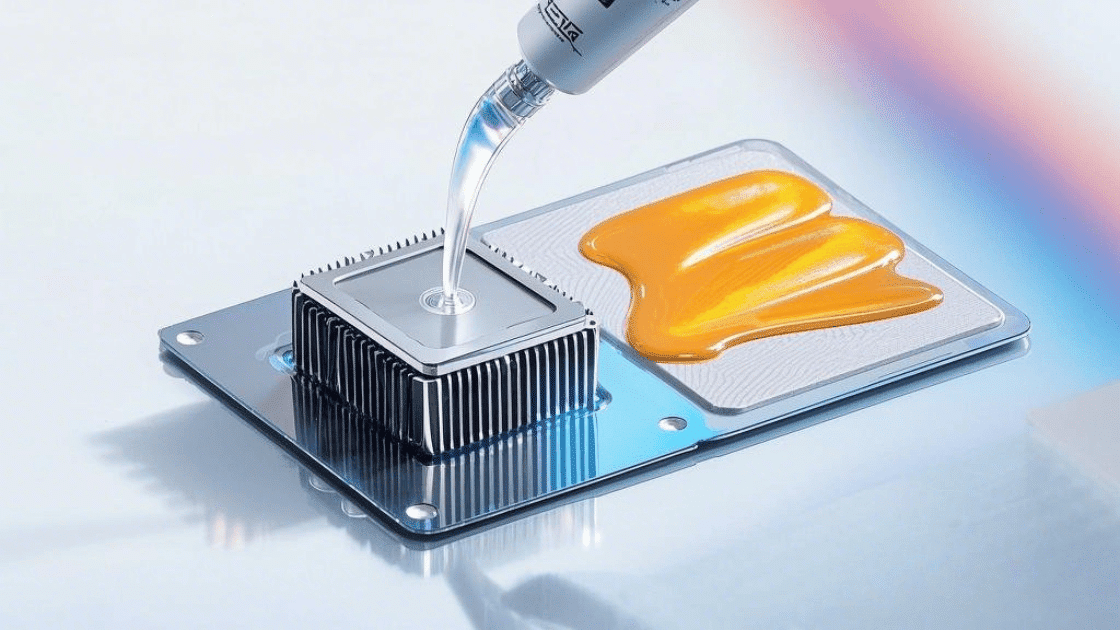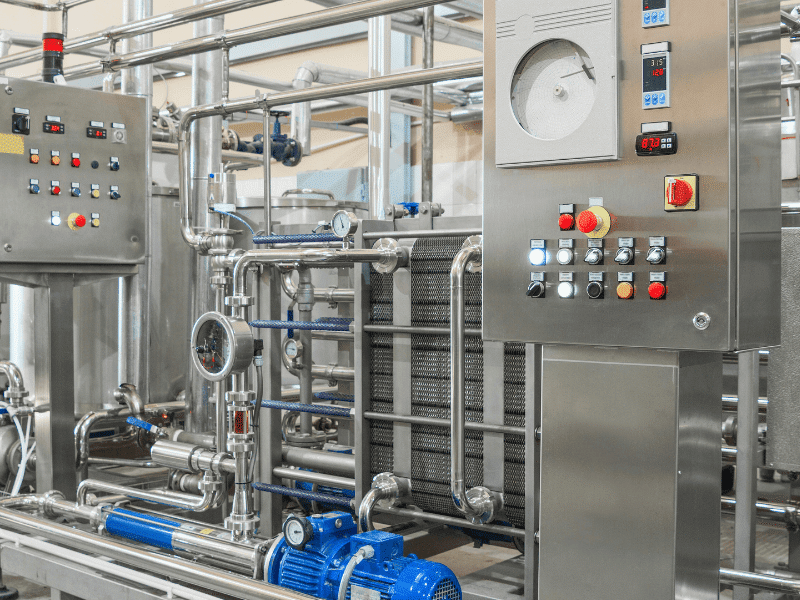Heat sink adhesives are useful components. They can be used to attach heat sinks to electronic devices like CPUs, PCBs, and GPUs. The adhesives transfer heat away from the part to the heat sink, keeping the devices cooler and firmly securing the heat sink.
This article discusses various types of heat sink adhesives, their applications, challenges, and testing aspects.
What is Heat Sink Adhesive?
Heat sink adhesive is a special thermally conductive bond. You can use them to make strong attachments between two surfaces, heat sinks, and/or other parts like semiconductors, CPUs, etc. Furthermore, these adhesives do more than just hold components in place; they remove excessive heat and cool down the parts. You can use them to fill the gaps without needing any screws or clips.
The given image shows how heat sink adhesive makes strong thermal contact. It demonstrates heat transfer from the SC to the heat sink using thermal materials (TIM) like CuW and CuMo. This maintains electronic device performance and enables efficient heat dissipation.
Types of Heat Sink Adhesives:
1. Thermal Tapes:
Thermal tapes are thin (0.05 mm to 0.2 mm) and sticky on both sides. These tapes are easy to use. Manufacturers use acrylic, silicone, or phase-change materials for thermal tapes.
Acrylic tapes are mainly strong and durable. Meanwhile, silicone tapes are the best options for flexibility and handling high temperatures (up to 200°C or more). Phase-change materials melt slightly when they reach 45°C to 80°C, better filling gaps.
2. Epoxies:
Epoxy adhesive generally uses a permanent bond. It comes in both types: one-component (ready-to-use) or two-component solutions. Mix two compound solutions well before use. Both adhesives offer strong attachments, but epoxy is the best choice for heavy-duty parts.
3. Silicone-based Adhesives:
Silicone-based adhesives are less strong than epoxy but offer flexibility. They can handle high temperatures and resist aging. They can be used for temporary to less permanent setups.
Properties of Heat Sink Adhesives
| Adhesive Type | Thermal Conductivity (W/m-K) | Thermal Resistance (°C/W) | Bond Strength (psi) | Operating Temperature Range (°C) | Cure Time (min) |
|---|---|---|---|---|---|
| Epoxy | 0.5-1.5 | 0.05-0.2 | 1,000-3,000 | -40 to 150 | 30-60 |
| Acrylic | 0.2-0.8 | 0.1-0.5 | 500-2,000 | -20 to 120 | 10-30 |
| Polyimide | 0.5-2.0 | 0.05-0.2 | 1,500-4,000 | -40 to 250 | 60-120 |
| Silicone | 0.2-0.8 | 0.1-0.5 | 500-2,000 | -50 to 200 | 10-30 |
| Ceramic-based | 1.0-5.0 | 0.02-0.1 | 1,000-3,000 | -40 to 250 | 30-60 |
| Graphite-based | 2.0-10.0 | 0.01-0.05 | 500-2,000 | -40 to 150 | 10-30 |
Properties of Heat Sink Adhesives
Thermally Conductive Adheres:
The thermal conductivity of adhesives shows how well they dissipate heat. For instance, an adhesive with a 1-3 W/mK conductivity is best for general use. In the case of high-performance parts, use adhesives with >5 W/mK for better thermal dissipation.
Manufacturers measure conductivity using tools like a thermal conductivity meter. They heat adhesive on one side and test how quickly it passes heat.
Additionally, several fillers, like ceramic, metal, or graphite particles, help improve heat transfer. Manufacturers mix them in adhesives during manufacturing.
Electrical Insulation:
Many heat sink adhesives (silicon and epoxy) contain electrical insulation attributes because of the material’s non-conductiveness by nature. This means they prevent flow or do not conduct electricity. Electrical insulation reduces short circuits in devices.
Viscosity:
Viscosity measures adhesive thickness in centipoise (cP). For instance, paste adhesives have a 10,000 cP viscosity.
High-velocity adhesive is often difficult to use but stays firmly on surfaces. In contrast, adhesives contain low viscosity, drip, or cause a mess but are easy to handle.
Curing Time:
The curing time of adhesive refers to the drying process. Many adhesives dry quickly ( 2 to 5 minutes), while others take up to 24 hours.
Manufacturers use certain tools like heat guns or ovens to speed up the drying process. For instance, in industrial places, they apply 80 to 100°C heat into epoxy to reduce curing time from hours to minutes.
Outgassing:
Outgassing is the natural process of releasing gases from components. Adhesives form gases as they dry.
Too much gas might harm sensitive parts like space or medical devices. For this, you can use adhesives that release less than 1% of their weight as gas.
Adhesion Strength:
Heat sink adhesive strength does not always remain constant. For example, epoxy bond offers higher strength (above 10 MPa), while tapes are not stronger and are removed easily.
You can measure them by strongly pulling bonded surfaces apart. Check how much force they use in megapascals (MPa).
Thermal Interface Materials
The main job of TIMs in heat sink adhesives is to improve heat transfer. They fill the tiny gaps, reduce air pockets, and make strong contact between surfaces.
For instance, the diagram shows a comparison of heat transfer with and without a TIM. Direct contact leaves air gaps and impedes heat flow, whereby using TIM reduces the surface temperature significantly. Additionally, it improves overall heat dissipation.
Importance of Heat Sink Adhesive
Heat Transfer and Thermal Management:
Typically, each electric part generates significant heat during operation. For example, overloading the CPU causes excessive heat up to 100-150 watts. Therefore, the removal of overheating is necessary in the case of protecting the device from damage.
Heat sink adhesives offer excellent thermal conductivity. They fill microscopic gaps as small as 0.01 mm to reduce thermal resistance. Just as this image shows, heat sink design.
Whereby a base wall represents the heat source dissipating the heat through numerous vertical fins (pin fin zone). Adding a top cap allows air to pass through the fins. That effectively transfers heat away.
These heat sink designs give enough area to move heat efficiently as well as let the device operate within safe temperature limits.
Role in Maintaining Optimal Device Performance:
Overheating slows down tasks. For instance, overheating in the CPU throttles its speed. It reduces performance by 30-50% and consumes more power.
Heat sink adhesive maintains the temperature limit. It lets the devices work at peak efficiency. Also, proper thermal management can increase lifespan by 20-30%, reducing the cost of repairing.
Consequences of Inadequate Adhesives:
Consider your project parameters while using any adhesive. Such as their temperature, fragility, materials, and uses.
Inadequate adhesive may increase thermal resistance (50% or more) due to improper gap filling. This causes hotspots whereby heat limits can spike to 100°C or higher. Hotspots damage the sensitive parts. It slows down their operations and causes malfunctions.
For example, using poor adhesive to bond the heat sink in the GPU may exceed the heat limit. It leads to crashes or even a complete shutdown.
Choosing the Right Heat Sink Adhesive
1. Heat Movement (Thermal Conductivity)
Measure the thermal conductivity of the chosen heat sink adhesive. For instance, you should use adhesives with 1-3 W/mK conductivity for LED lights, PCBs, or power transistors.
Higher conductivity (up to 8 W/mK) also moves heat well between heavy-duty devices like servers or electric vehicle batteries. Using the wrong adhesive may lead to poor heat movement or reduced lifespan.
The visual shows a heat sink system for electronic parts, effectively dissipating heat generated by the IC. The engineers mount this heat-generating chip (IC) on the PCB. They use TIM1 and TIM2 adhesive. That improves heat movement between the chip, heat spreaders (HSP), and the main heat sink (HS).
2. Temperature Resistance:
Heat sink adhesive must resist high temperatures. For instance, 100-150°C resistance works best for home electronics.
However, high-performance parts like car engines or industrial machines need 200°C or higher resistance. Low-temperature handling adhesives are suitable because they break down, leading to poor performance.
3. Surface Cleaning and Preparation:
Prepare surfaces to create a strong bond. For this, 90-99% isopropyl is used to clean deep, detailed parts. Remove dirt, grease, and oxidation. Do not forget to sand lightly on rough surfaces to ensure the adhesive works as intended.
4. Preventing Electrical Issues:
Circuit boards or sensors need adhesives with electrical insulation. Because these bonds prevent short circuits and electrical leaks. Silicone-based work is better in this case. For instance, manufacturers use non-conductive adhesives (>10^12 ohm-cm resistivity) in power supplies.
5. Thickness and Flow:
Adhesive thickness matters while filling the gaps. For instance, 0.1 mm-sized gaps need low velocities of up to 10,000 cP, such as smartphones. Conversely, larger gaps (up to 0.5 mm) of industrial motors need thicker adhesives.
6. Curing Time Needed for Adhesive
Adhesive bonds cure at different times. That depends on their types, form, and chemical structure. Some bonds can cure in 5 to 10 minutes, while others need an entire day.
Fast-curing adhesives are suitable for quick fixes. Slower-curing bonds work best in complex designs. It allows you to make adjustments during applications.
7. Material Compatibility:
Select the adhesives that perfectly fit your device material. This means it should not harm the object. For example, you can use epoxy glue for metal bonding, or for plastics, take one (silicon) that won’t crack or peel off over time.
Challenges and Limitations of Heat Sink Adhesives
Thermal Degradation:
Constantly exposed to high temperatures can break down bonds. Intense temperatures affect their strength and thermal conductivity. As an example, silicone heat sink bonds can degrade 20-30% when exposed to prolonged heat.
Moisture Sensitivity:
Adhesives can absorb up to 2-5% moisture. This is often because of a humid environment. Moisture reduces its bond strength by 15-20%. Use sealed containers to store adhesives with less than 40% humidity.
Aging and Degradation:
Oxidation or UV exposure is the main cause of adhesive aging or degradation. As a result, the bonds can harden, crack, or lose flexibility.
Strategies for Mitigation:
● You can apply several barrier coatings, like titanium dioxide and zinc oxide. These coatings help protect adhesives from moisture and UV rays.
● Try to store adhesives in cool, dry places below 25°C.
● There are many anti-aging additives available to use with adhesives for longer durability.
Heat Sink Adhesive Testing Methods
Bypass Method:
The manufacturers first attach the heat sink to the heat source without using adhesives. This is because they want to measure the baseline thermal performance and how much it can handle heat movement and cool parts on its own.
Flow Blockage No Bypass Method:
In this stage, manufacturers block the airflow to initiate poor ventilation. This allows them to determine how well the adhesive works in critical situations.
Sandwich Heat Source Method:
Manufacturers make sandwich heat sources using two heat sinks. They place a heat source between them and apply adhesive to both sides. This method helps them to monitor evenly distributed heat.
String for Suspending Heat Sink Method:
Suspend the heat sink Using string to isolate its effects. This technique helps calculate thermal performance without physical contact. This method keeps the adhesive’s effectiveness apart to show how it changes temperature, e.g., from 100°C to 70°C.
Common Oversights:
● Do not neglect environmental aspects while performing tests. Such as humidity, dust, or temperature fluctuations. For instance, 60% humidity can impact adhesive performance up to 10-15%.
● Each method may not be suitable for simulated real-world conditions. For example, poor airflow or uneven surfaces result in erroneous outcomes.
● Test adhesives for long periods instead of short periods. Long-term aging (e.g., over 1,000 hours) helps assess durability.
Heat Sink Adhesives in AI Hardware
Heat sink adhesives are decisive for AI hardware. For example, AI servers and GPU clusters create a lot of heat. So these systems use powerful chips. Interestingly, these chips need to stay cool to work well. Heat sink adhesives help move heat away from the chips. Good adhesives must conduct heat well.
Conclusion:
Heat sink adhesives significantly improve heat movement in electronic parts. They keep devices cool. Using the right adhesives, you can prevent overheating and extend device’s life span. Also, several aspects like thermal conductivity, temperature resistance, and proper testing for better outputs should be considered.
Jiuju specializes in high-performance thermal management solutions, offering a comprehensive selection of heat sink adhesives and epoxies. Our product line includes thermal tapes, epoxy adhesives, and silicone-based solutions engineered for superior thermal conductivity, strong bonding, and reliable performance. Contact us for a custom solution.





